I'm not a huge fan of flourescent lights although they do run cool. I don't like the quality of light they produce and they tend to fade things out from the uv rays they emit. So fellow forumites, what type of lighting do you all use, why did you opt to go that route, and what have you found to be the advantages and disadvantages?
I'm not a huge fan of flourescent lights although they do run cool. I don't like the quality of light they produce and they tend to fade things out from the uv rays they emit. So fellow forumites, what type of lighting do you all use, why did you opt to go that route, and what have you found to be the advantages and disadvantages?
Replies sorted oldest to newest
FWIW, I have been using screw-in CFL's for about 15 years now. If there has been any adverse effects on fading, I haven't noticed any.
I just changed the CFL in the far corner to a 40W LED. I don't know if this will make a difference.
Artie
Just a thought for you here.
Have you tried different hue/color (whatever they call it?) bulbs like 3100k or 5000k etc? I have the 4' fluorescent "shop light" types in the basement and they are cool and the light is good for me. Haven't noticed any fading of anything in over 30 years of having them. What I have noticed is the type of bulb you get makes a difference in the light they put out. Over the years I find the Daylight to be preferred to the Cool White or others they have (I think there are other colors/hues as well). Daylight costs a bit more than the cool white, at HD anyway.
My wife had plant lights with grow bulbs (now gone), they might be the ones that fade things, though never noticed it from those either.
Don't know if the CFL screw in bulbs are available in the different colors/hues?
Edit: Just went & looked, Daylight Deluxe at 6500k is what I have, I am also getting old and don't see as well as I used to, lots of light helps.
Have been using 92 CRI 4500 Kelvin T-8 tubes for 15 years. Just added some similar grade with T-5 fixtures. Wish the whole room was done in T-5s.
I use halogen bulbs in recessed "can" lights. The near daylight color provides a good solid even lighting for me. I have been looking at LED's but as others note the color temp is important.
Yes, CFL's come in different hues. They have at least "warm white" at around 2700 degrees Kelvin, "bright white" around 3500 and "daylight" around 5000 to 6500 depending on the manufacturer. I have a 1500 sq. ft. layout space with track lighting aimed at the layout. Tracks are placed 1 foot into the aisle from the layout edge.
There are 100 bulbs in the track lighting. I originally used 60 watt incandescent "fan bulbs" (meant for ceiling fan fixtures) for a total of 6000 watts of light and power usage. The lighting was divided among 4 heavy duty dimmer switches so I could dim the lights for twilight effects. In 13 years I never really did that.
After being on for a few hours, the room got pretty warm. It was actually more comfortable in the Summer months because there are 4 A/C outlets in the ceiling that I could open to help keep the room cool. My wife wouldn't have liked it if I ran the A/C in the Winter to keep the layout room cool.
I changed to CFL's 3 years ago and have been very happy. I bought a half dozen or so of each color hue and tried them out. In my basement, I liked the "warm white" the best since they looked the most like the old incandescent bulbs. I noticed that the colors of my structures looked different under "bright white" or "daylight" bulbs. In particular, I custom mixed some PRR structure paint colors so they looked right under the old lighting. These structures looked much too gray (as opposed to a brownish gray) with the brighter lighting.
I also found that the 13 watt CFL's (made to replace a regular 60 watt bulb) were much brighter than the 60 watt fan bulbs. I use 9 watt CFL's (supposedly 40 watt replacements) and they look great. In a couple of places where I need to shine light about 8 or 10 feet from the track light can, I have used the 13 watt bulbs.
My electric usage has dropped from 6000 watts to just over 900 watts and the room is now cool for as long as we want to be down there.
What ever type you get you want the temperature to be close to 5600k. Daylight is not of course always at 5600k but it's a good average to shoot for. Don
I use flourescent tubes and incandescent together. It is what I have so I use 'em.
.....
Dennis
I use track lighting with screw-in CFL flourescent lights for the main lighting, and a ceiling fan with four CFL's.
Installed blue rope lights for night time look, and a small flourescent black light.
Put small lights inside my Plasticville houses with low voltage from a Lionel transformer using 14.4 volt light bulbs from Radio Shack.
Lee Fritz
I use 8 foot high out put flouresents in my garage\layout room. I have a 20X20 garage and I have enough light for layout and mechanic work. Long life is assured.
Works for me.
Al![]()
I just started working on my layout lighting today. I decided to go with standard screw base sockets spaced 4' apart to light the lower level. For bulbs, I'm leaning toward the smaller CFL's that only use 13 Watts. I hope I can find them in the right color.
For the quantity I would need LED's are still too expensive.
For my work bench I use 4 foot flourescent lights, very good lighting and low cost and don't get hot.
Lee Fritz
I use cheap LED flood and spot lights. Most have 16 at least color choices you can select by remotes that come with them. They are dimable to a point.
You can really change the mood with the colors and highlight different scene settings.
Like 12 bucks each on eBay or the like.
I have a five shop light fixtures with two 40" flourescent tubes in each one. I also have two 100 watt incandescent recessed fixtures but only use these when not using the layout.
I have both florescent and Incandescent lighting and it look's very nice
Alex
I use 4 foot fluorescent tubes. I have the fat ones and the skinny ones too. I forget the numbers. But, they must have some kind of heat sensor because when it gets too humid they shut off. Does anyone else have this problem?
Rick
As I mentioned in my post, this layout is going to be quite a bit larger than the last one which was also my first layout. I'm still in the steep part of the learning curve on all this even though I have been at it for about 5 years now. So I'm going to be posting a lot of questions here in the near future. Again, thank you for your all's help!
Hi Andy,
If your objective is have realistic lighting that's also useful during construction, the best starting point is 5000K florescent with a 90+ CRI. You can use inexpensive fixtures with good quality bulbs and have VERY attractive lighting. Photographers use 5000K florescent bulbs in their studios to duplicate outdoor direct sunlight. Here's photo from the NWTL model railroad that was taken with only 5000K florescent lighting.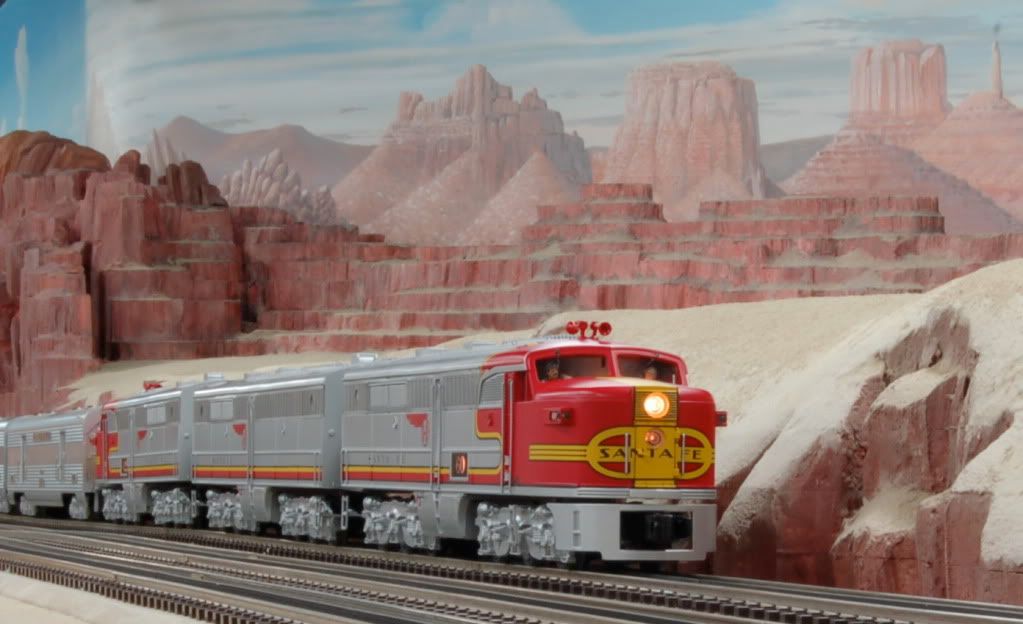
If you want to duplicate more than just high noon you should consider adding halogen incandescent floods in either track fixtures or recessed can with an aimable trim. The halogens can be wired to a dimmer switch and aimed at a shallow angle to duplicate morning and afternoon shadows. With 5000K florescents and aimable halogens you can get results like this...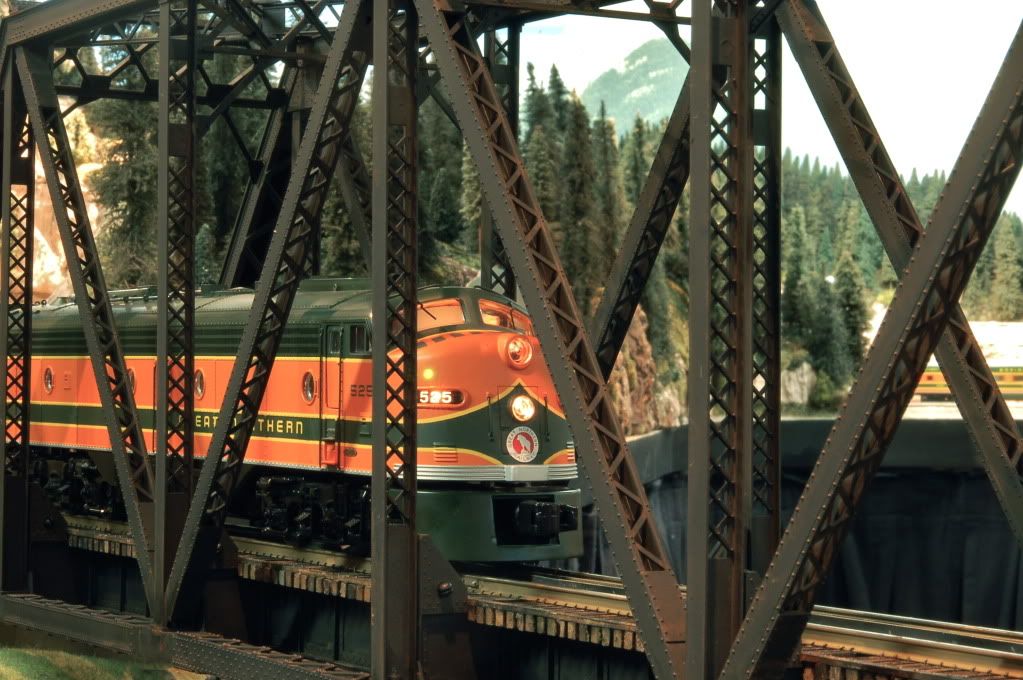
For most folks the combo of on/off 5000K florescent and dimmable halogens offers a cost effective lighting package with attractive results. Those with a little bigger budget can consider making the florescents dimmable as well. Good dimmable ballasts cost about $100 each, so the cost increase is significant.
The other major enhancement that can be made is to add colored lighting at the base of the backdrop. This can be done at very little cost with christmas lights or rope light. Using red, green, and blue lights on independent dimmers will allow you to mix any shade you wish. Here's a video that shows the effect of all these elements (5000K dimmable florescent, aimed dimmable halogens, and RGB rope lights) together on a single layout. This video is a montage of stills taken with the exact same settings on a digital camera.
Dave,
Check out the new IOS controlled Hue lighting from Philips.
It is amazing.
You can dial up a sunset, sunrise, or rain.
All from your phone or tablet.
Scrappy
Andy....there have been some very long and interesting discussions about lighting here on the forum. If you do a little searching, you should be able to find them...the most recent having a lot of very good information that will help you make a decision. But I do want to say that you should not rule out tube florescent lights. Good recent research indicates that fading of colors is not the problem that folks think it to be especially after the light itself is more than a few feet away for the surface it is lighting. In any case...there is and was plenty of debate on that fact here on the forum...some of it got about as hot as those 6000 watts Bob had going on in his room at one time!!![]()
In my room, I use Philips F96T12/DX/ ALTO tubes that are 6500K. The lighting is great for pictures and lights up a room that is about the size of your room but mine is located above the garage and has 10.5 foot high ceilings. I have been very happy with my choice since I enjoy the photography end of this hobby. Sometime in the future, I will be adding just a few LEDs or Halogens in some track lighting only for some dramatic light / shadow effects.
Alan
We decided to go with a DIMMABLE CFL, Par38, 5000k, 23 watt (equal to 75 watts), and used 32 of them I think. They cost a bit more than the non-dimmable version, but well worth the adjustability. We tried Par30's but they just didn't have the volume as the Par38, but the bigger bulb does require a different style head to accommodate it's size. We had some 75 watt Halogens, and warm incandescent bulbs in there, but it really looked yellow in the room. Not to mention the amount of heat was great great, we couldn't have them on very long as the room would start to bake us.
The 5000k color temp is great...very bright and clear, not yellow like a 2700k bulb.
PAR30 vs PAR38
Different style track heads give you more options for bulbs.
Halogens and incandescent = yellow and tons of heat!
Attachments
I use four ft. fluorescent bulbs over my workbench. I use four ft. Fluorescents and track lighting halogens over my train layout. Fluorescents when working on my layout, and both or just dimmable when running trains. The fluorescent bulbs are covered with UV filtering covers.
I have several walls of my collection in a few basement rooms. I use clear UV covers on the flourescent bulbs. I got the covers from a book binding company that services libraries. I also have the fairly small windows covered with UV filtering vinyl window film. I had some cars from a basically inexpensive train set change colors in front of a window which gets no direct sunlight. Thus the reason for protection.
Bill Berresford
I use flourescent tubes and incandescent together. It is what I have so I use 'em.
.....
Dennis
I agree with Rich in his use of halogen bulbs in can lights. This has worked very well for me over the past seven years.
Take a look at this popular mechanics article which talks about Incandescent/CFL/LED bulb power spectral density. Basically it will show you why you can't see well with CFL bulbs and why a proper LED bulb will allow you to see everything much better. You need to click on "view larger" under the bulb pictures to see the power spectral graphs.
I dislike tube lighting and would avoid it on my RR at all cost. However Incandescent can be very hot. I have 4 fixtures that take 4 60 watt bulbs for a total of 960 watts in my train room. They produce a lot of heat!
Basically it will show you why you can't see well with CFL bulbs and why a proper LED bulb will allow you to see everything much better.
You can't see well with a CFL???? That's a 1st. We have over 30 of them in the train room and "seeing well" is definitely NOT an issue. Sure we would of liked to use LED's but at $40 a piece times 30+.....$1200 for bulbs alone.... Seeing well is NOT a problem with CFL's I assure you.
Track lighting with CFL bulbs, only consume 14 watts each and there is a noticeable difference in the temperature in the room. Have 50 light fixtures in the room, when the older 65 watt floods were in there they would generate a lot of heat. The room is much cooler and cost's less to operate!!
I have a CFL and an Incandescent in each area over the layout, this will be upgraded as I rebuild to add more lighting.
I must mention I absolutely HATE CFL's.
They have slow response to turn on, they may not come on at all or stay dim if it's cold and they are full of Mercury. Ever look at the required disposal for one???
Lord help you if one breaks, its a hazmat condition these days.
Now, I do have a few of them I bought as a test, the double enclosed versions.
Yes, they save a lot of watts and run cool. I Still Hate them. Slow to brightness, hardly light at all in the winter inside my basement, Chill but not freezing.
And one pair burned out in about 6 months, so much for the long lasting aspect.
I'm running one that is 5600K and I find the light is odd to me. Too many years under incandescent I guess. Then again, Is it really 5600K ? How do I measure that?
I think I'll end up with LEDs, I like the Tech a lot more. And those are easy to work with for me.
Work lighting system is 2'X4' 3 tube lay-in fixtures with (3) F32 T8 tubes (2) fixtures in one room, (3) fixture in the other room.
Under layout work lights are compact cabinet lighting with V20w quartz lamps (3) lamps per fixture. The fixtures have a (3) position High/Low/Off switch.
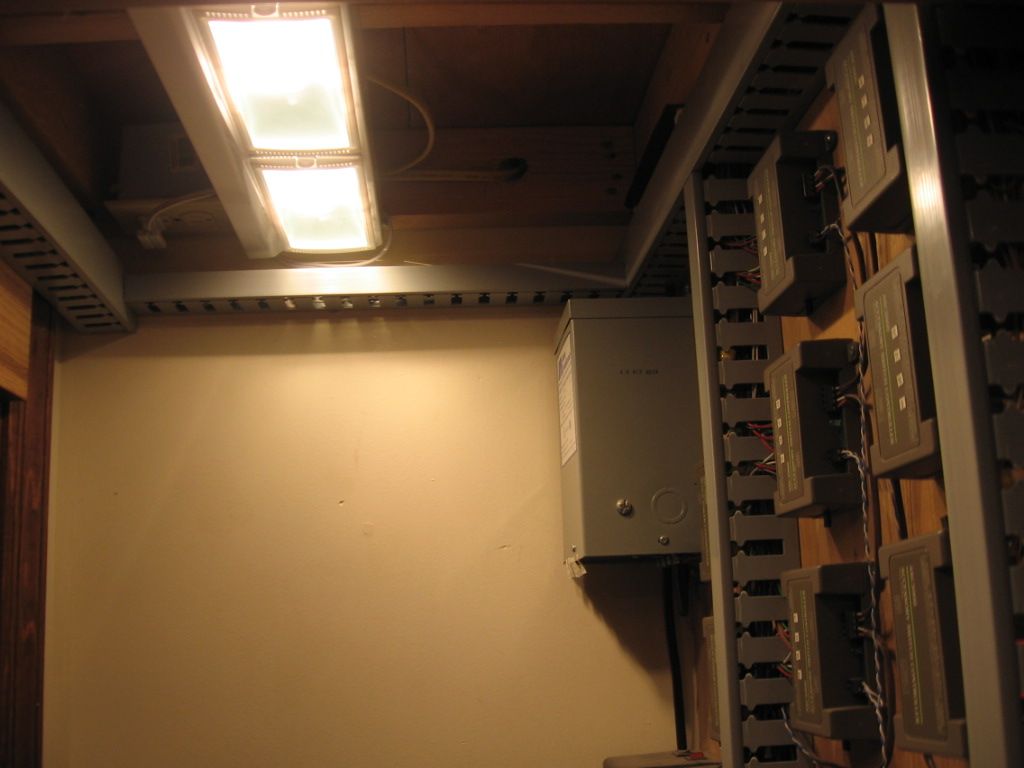
Track lighting that has two different heads.
Exposed bulb is a 60watt R16 lamp a fair spot lamp.(15) fixtures.
Cover head is a 50watt R20 flood lamp. (16) fixtures
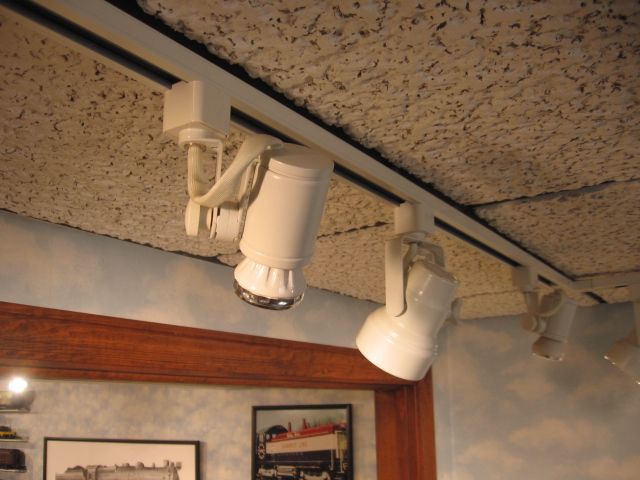
Camera walk around of the (2) room lighting. Click on the underlined phrase to access a slideshow. Lay-in light fixture are not on.
Recess 4"Round down lights. (7) with 40watt R16 lamps
Recess 4" Round down light (eye ball adjustable) (4) with 40 watt R16 lamps.

Train shelf lighting.

Coal tipple lighting Recessed eyeball lights.
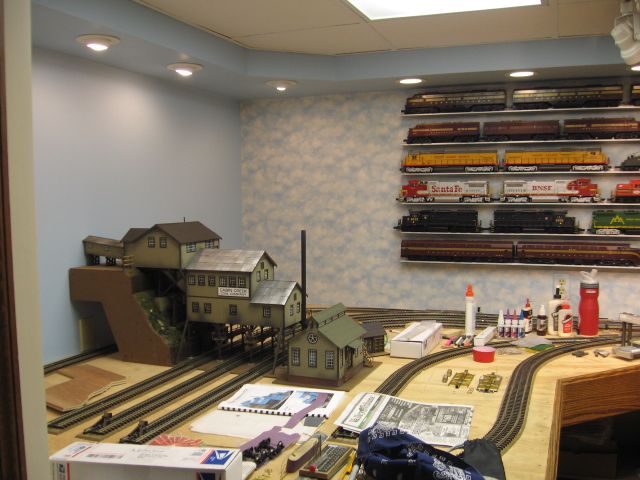
Light Emitting Diode strips and compact flourescent light bulbs a ore what I use to generate light without much heat.
Andrew
Mediocre can lighting.
My train room lighting is mostly diffused sunlight from a skylight. Lighting at night is from a pair of 3-bulb fixtures attached to the twin ceiling fans. Most of my train time is during the day anyway, so the artificial light is of secondary importance. As I get time to improve the lighting, I will most likely replace the ceiling fans and their light fixtures. The new fixtures will have halogen or LED floods with barn doors to control the lighting. Once I see how this works out, I may decide to add some additional spots or accent lights, possibly with colored filters.
I do not like or trust CFL's. Many of the manufacturer's color temperature ratings or descriptions are inaccurate. I did some comparison tests of CFL bulbs in a pair of neutral white glass globes and the colors were all over the place, ranging from bright pink to an eerie blue reminiscent of old science fiction movies. Professional grade bulbs marketed for photography are another matter, they generally do match their ratings, but you don't find them at the corner Wal-Mart. And, of course, the mercury creates an environmental problem when they are disposed of. As the price of LED's comes down, CFL's are going to be seen as the politically motivated stopgap they are.
Attachments
I use florescent for working and I have prewired track lighting for when the layout is finished.
Pete....I just wanted to say that I have always enjoyed your pictures of the layout. The one above is so nice! Sure would like to know more about your layout. It is beautiful!!
Alan
I use four sets of 2'x4' fluorescents in a drop ceiling plus three 4-light, variable incandescent fixtures as track lighting. Works really well as they are all on individual controls.
The layout is 9'x13' in a 20'x22' room.
Several things about lighting that I learned from our son-in-law, a director of photography ("cinematographer") working in the Hollywood industry: lighting is personal, each has his or her own taste, so DO what looks best to YOU (and be prepared to be roundly critiqued by professionals, as I have been. LOL!)
Here is a link to a recent thread by Elliot Scher . An interesting colored light and light control system. Click a Sunset.
![]() Thanks Elliot
Thanks Elliot![]()
Mike




